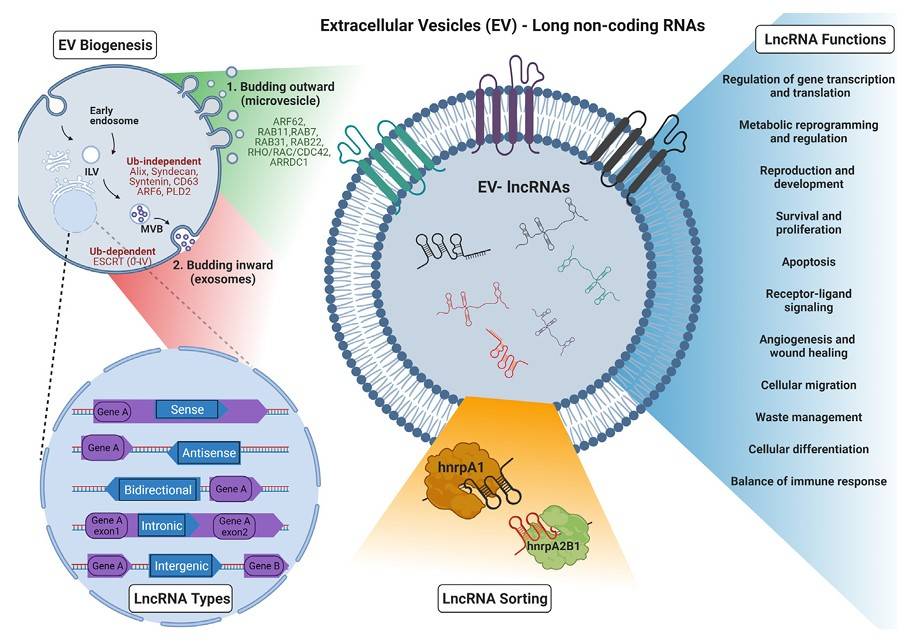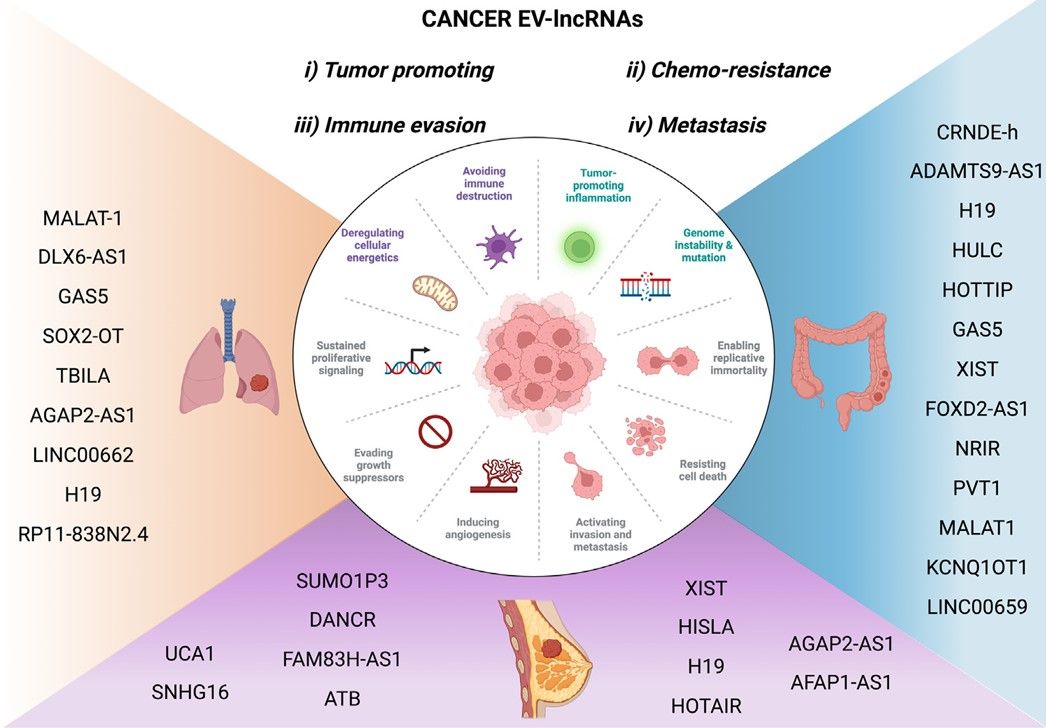Extracellular Vesicle lncRNA Sequencing Service
Overview Services Features FAQs
Creative Biolabs provides EVs lncRNA sequencing services with our comprehensive EVs RNA sequencing and profiling platform, supporting our clients in the research of the lncRNA composition of EVs and their function.
Introduction of lncRNAs Enriched in EVs
lncRNA is a family of RNA molecules longer than 200 nucleotides that interact with proteins, DNA, and RNA but do not encode any proteins. They participate in several biological activities, such as chromatin remodeling, transcriptional control, mRNA stability, mRNA splicing, and gene regulation.
Exploring lncRNAs and their function in EVs is an emerging field of research. The lncRNAs in EVs can trans-cellular transport using distinct pathways than other lncRNAs. Studies have shown that lncRNAs are abundant in EVs and may be involved in communication between cells and tissues. The lncRNAs in EVs of tumor cell origin have been found to engage in a variety of cellular events based on vesicular delivery, and may act as regulators of apoptosis, tumor invasion and metastasis, and angiogenesis. For example, lncRNAs enriched in EVs secreted from HeLa cells and MCF-7 cells including MALAT1, lincRNA-p21, TUG1, and CCND1-ncRNA could reflect DNA damage responses in parental cells. Under hypoxic conditions, bladder cancer generated EVs rich in lncRNA-UCA1, while lncRNA-UCA1 might facilitate tumor cell invasion and metastasis by controlling the epithelial-mesenchymal transition pathway. Through glioma cell-derived EVs, LncRNA HOTAIR in glioma cells may increase VEGFA expression levels and improve endothelial cell angiogenesis.
 Fig. 1 Extracellular vesicles-derived long non-coding RNAs — EV biogenesis, lncRNA types, sorting and function.1
Fig. 1 Extracellular vesicles-derived long non-coding RNAs — EV biogenesis, lncRNA types, sorting and function.1
Steps of lncRNA Sequencing for EVs at Creative Biolabs
-
Isolate EVs from biological samples using ultracentrifugation or other methods.
-
Purify RNA from EVs using column-based or bead-based methods.
-
Quality check and quantify the purified RNA.
-
Prepare sequencing libraries using appropriate kits.
-
Sequence the libraries on a suitable sequencer.
-
Map reads to reference genome.
-
Identify and quantify lncRNA using bioinformatics tools.
 Fig. 2 EV-lncRNAs in cancer.1
Fig. 2 EV-lncRNAs in cancer.1
Significance of lncRNA Sequencing in EVs
-
Sequencing of EV-associated lncRNAs allows for more accurate measurement of EV-associated lncRNA expression and is significant for gaining insight into the lncRNA composition and function of EVs, as well as their role in intercellular communication and disease. It could lead to clues for their roles in gene regulation, epigenetic regulation, and cell proliferation.
-
The levels of EV-associated lncRNAs vary with disease specificity, and thus, they can be applied as biomarkers for disease diagnosis and prognosis.
-
Sequencing of EV-associated lncRNAs allows the detection of novel genes involved in disease pathogenesis, as well as the identification of regulatory mechanisms of novel genes, an approach that provides insight into the functional role of EV-associated lncRNAs in intercellular communication.
Creative Biolabs provides lncRNA sequencing services for EVs to help clients identify and characterize the types of lncRNAs present within EVs. Our comprehensive lncRNA sequencing analysis platform supports both standard and customized analysis to meet your needs, including differentially expressed gene analysis, gene structure analysis, novel lncRNA prediction, and target gene prediction. Please contact us to convey your interest.
FAQs
Q: What is lncRNA sequencing service for extracellular vesicles?
A: Long non-coding RNA (lncRNA) sequencing for extracellular vesicles involves the comprehensive analysis of lncRNAs present within extracellular vesicles (EVs). This service helps in understanding the regulatory roles of lncRNAs in intercellular communication and disease mechanisms.
Q: Why is lncRNA sequencing important for studying extracellular vesicles?
A: Extracellular vesicles are known to carry various biomolecules, including lncRNAs, which play crucial roles in cell-to-cell communication. Studying lncRNAs within EVs can provide insights into their roles in physiological processes and disease conditions.
Q: What are the applications of lncRNA sequencing in EVs?
A: Applications include identifying novel lncRNA biomarkers for diseases, understanding EV-mediated RNA transfer mechanisms, studying lncRNA regulation in cellular processes, and exploring therapeutic potential through EV-associated lncRNAs.
Q: How is lncRNA sequencing for EVs performed?
A: It typically involves EV isolation, RNA extraction, lncRNA library preparation, sequencing using high-throughput technologies, and bioinformatics analysis to identify and characterize lncRNAs present in EVs.
Q: What are the benefits of using lncRNA sequencing services for EVs?
A: Benefits include obtaining comprehensive profiles of lncRNAs within EVs, discovering new insights into intercellular communication mechanisms, and uncovering potential biomarkers or therapeutic targets associated with lncRNAs in EVs.
Reference
-
Spanos, Michail, et al. "Expanding the horizon of EV-RNAs: LncRNAs in EVs as biomarkers for disease pathways." Extracellular Vesicle 2 (2023): 100025. Under Open Access license CC BY 4.0, without modification.
For Research Use Only. Cannot be used by patients.
Related Services:

 Fig. 1 Extracellular vesicles-derived long non-coding RNAs — EV biogenesis, lncRNA types, sorting and function.1
Fig. 1 Extracellular vesicles-derived long non-coding RNAs — EV biogenesis, lncRNA types, sorting and function.1
 Fig. 2 EV-lncRNAs in cancer.1
Fig. 2 EV-lncRNAs in cancer.1








